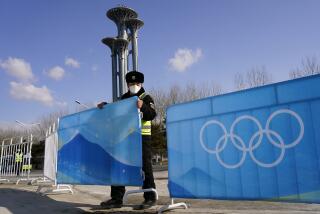If Public Spaces Dwarf Humankind, So Do Politics
The buildings that surround Tian An Men Square are immense and impenetrable. The square itself, like Red Square in Moscow, is a place where scores of 80-ton tanks can parade, a place for a train of missiles, or for 50,000 marching men. On that vast stone pavement, a single human being is like an insect.
Where could such a parade be held in the United States? If it were on the Mall in Washington, the marchers and tanks would have to splash through the reflecting pool, avoid falling into the Vietnam Memorial, try not to sink into Constitution Gardens, then split for the Washington Monument and dodge the fountains and pools at the base of the Capitol. A missile couldn’t make it. The Mall is a better place to play Frisbee with a dog, to sit on benches, to visit the museums, or to stroll in pairs. The buildings around the Mall are totally open, meant to be walked through and inspected, to be visited again and again--an open state in microcosm. The Mall is heaven for a curious person, for an affectionate couple, or for a squad of Boy Scouts. It has been claimed by the people.
One can consider the center spaces of the capitals of other states and take a rough reading of their politics. The Zocalo in Mexico City is a vast and barren expanse, regularly used for rallies and other displays of power by the party that has not shared power for six decades. The Champs Elysees in Paris is grand and inspiring, yet it too could serve to host a vast armored procession. In fact, the Nazis put it to that use once. The French have historically had a penchant for extremism and their capital’s architecture betrays that potential. London has many parks, but no broad triumphal ways or vast, human-dwarfing squares. No one since Cromwell has attempted to play Mussolini. (Oswald Mosley, the failed fascist of the 1930s, was an exception, but he complained that there was no Nuremberg, no proper place for a mass rally, in Britain.)
The great cities of antiquity like Luxor, Persepolis and Babylon, as well as the pre-Columbian cities like Teotihuacan and Chichen Itza, were human-dwarfing in their design and scale. They were stage sets more than they were cities. The great avenues between the temples were for processions, not for persons. They were ritual grounds, awesome precincts for the priesthoods, instruments of theocratic rule, meant to intimidate the individual. A mere person, caught between temples in a barren expanse, feels the urge to scurry for cover like a roach.
Athens was the first city built on a human scale. The paths up the Acropolis are winding, the streets of the agora are narrow and designed to serve commerce and communal life. The stoas and the temples are open and small. They welcome people and do not humble them.
Democracy--government on a human scale--found its expression in human-scaled architecture. On the other hand, the 20th Century has also brought forth many human-dwarfing cityscapes. It augurs badly for the people of Romania when Nicolae Ceausescu bulldozes the center of Bucharest to build a “Palace of the People,” and the people of Zaire should not be impressed when Mobutu Sese Seko clears away buildings to create a great processional way in Kinshasa. In a land where the buildings dwarf the person, the politics are likely to do the same. In a land where the center cities are on a human scale, the politics will be humane also.
The students and workers in Tian An Men Square understood this intuitively and proclaimed their purpose exactly. They said they were out to reclaim the square for the people. That bloodied ground has never been a place for individuals, however. For centuries it served to display the power of the imperial elites, and now the Communist Party uses it for the same purpose. The demonstrators briefly defied its vastness, tried to make its space their own, to occupy and humanize it.
On the night of June 4, the party reclaimed its square and made it again the vast, empty, oppressive domain of the new theocrats. The god-sized icon of Mao has been scoured of the paint splashed on it, and gazes again over a no-man’s land where the people scurry through, where tanks and missiles again will roll.
More to Read
Sign up for Essential California
The most important California stories and recommendations in your inbox every morning.
You may occasionally receive promotional content from the Los Angeles Times.









